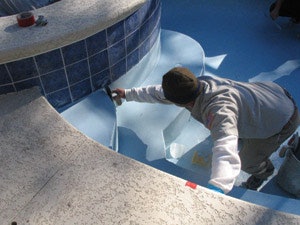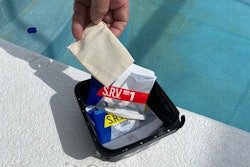
"It's the biggest thing that we come across as pool plasterers," says Jon Temple, president of Tempool, a pool plastering and plaster maintenance firm in Jacksonville, Fla. "The blame has always been put on the material or the installer.
"We mix it up, we trowel it down and everything is great, and then a week or two weeks after we leave it starts looking bad. We wanted to know why this was happening; is it our fault, and if it is, what can we do to change it and make it better?"
Alan Smith, an active member of the National Plasterers Council and chair of the association's research committee, echoes Temple's sentiment.
"There's always been a battle with spot etching," he says. "They'll say it hasn't been troweled right and that that makes it more susceptible to etching. Until now, people have wanted to look at that as more the problem, and that's just turned out to be completely false."
Smith's assessment draws on the results of research he helped the NPC set up at the California Polytechnic State University, or simply Cal Poly, in San Luis Obispo. Though Smith had done some of his own research on the topic, he and others at NPC realized they needed the credibility that only an objective third-party research facility like Cal Poly could provide.
The first of four phases of the research is complete, and Smith and his plastering colleagues are happy with the results, which he says point to chemical imbalance, choice of plastering material and even outdated ideas about certain testing parameters as the culprits. Feeling vindicated, he's on a mission to spread the word to the public and the trade about what can be done to remedy existing problems and greatly reduce the likelihood etching problems will crop up again.
This is welcome news for plasterers like Temple.
"We pool plasterers all have our own way of fixing things," he says. "But by using Cal Poly and the funds that they have, now we know the reasons why it happens and how to fix it. So that in itself will save me a couple of hundred thousand dollars a year, all because of stuff we've learned directly from Cal Poly."
CYA And Total Alkalinity
Perhaps the study's biggest finding was that high levels of cyanuric acid are a significant contributor to spot etching, according to Smith. That's not to say high cyanuric acid is directly to blame, though.
"You can't say high cyanuric acid causes spot etching; it's not the mechanism that does that," he explains. "But high cyanuric levels above 100 do give a false reading on the total alkalinity. So in other words the higher your cyanuric goes, the less you get an accurate total alkalinity reading."
This inaccurate TA reading comes about because in the alkalinity equation, you subtract 1/3 of the cyanuric level. If that cyanuric level is 300 and the service tech thinks it's only 100, he'll subtract 33 when he should be subtracting 100.
"Say you're a pool service guy and your cyanuric is at 200 or 300 ppm and you don't know it because your test kits only go up to 100 ppm. The tests just keep showing 100 and 100 and 100," Smith says.
"So your service guy is testing the pool and it shows that the cyanuric is at 100, so he thinks that's where it is, but it's really a lot higher. And you look at your total alkalinity and that shows, maybe 80, and your calcium hardness 200 or 250. So you think everything's balanced. But the fact is that your cyanuric might really be at 200 or 300 and you haven't measured it properly. That's a problem we've had within this industry for so very long. You do the conversion on the cyanuric being that high to the true carbonate alkalinity, which might be at 20. But you think it's 80. Well a 20 alkalinity with a 200 or 250 calcium will just dissolve any cementicious product."
Smith says his personal experience with examining spot-etched pools bears this out, and that "95 percent" of the ones he's seen had extra-high cyanuric levels that hadn't been measured properly.
This knowledge, and the testing that backs it up, will be a strong weapon in the plasterers' effort to convince homeowners that spotty pools don't mean shoddy plaster, says Temple.
"When we would go out and meet with the homeowner, we'd say, 'It's not bad material or a bad job, it's that your chemistry is off,'" he says. "They'd say, 'No, I use a pool cleaning company and they've been doing business for 20 years. They say it's your fault, so it's your fault.'"Now, we can say, 'Cal Poly, which is a very fine school with a fine testing facility, has done all the research.' It's not that they have a bad pool; it can be fixed. And this is how we fix it."
Surface Tension
While Smith feels plasterers have been vindicated by the findings linking the etching problem to unmeasured high levels of cyanuric acid, he's quick to point out that the problem isn't simply solved and that plasterers do bear responsibility for further educating themselves about water chemistry and its effects on the different surfaces they work with.
He traces the roots of the spot etching problem back to a generation or more ago, when plasterers turned away from harder aggregates to the softer ones that are so common today. The decision was then and is still often an aesthetic one — and one with unforeseen consequences.
"In the very beginning of pool plastering history the aggregates that were used in the material were more of a quartzite- or silica-based, very hard aggregate," he explains. "Probably in the late 1950s, early 1960s, those started switching to a marble-based or calcium-based plaster, which is very soft and soluble. The reason they did that is because it was a lot whiter and prettier to look at, and the builders were demanding a whiter aggregate.
"Now, those new, whiter aggregates were prettier and actually easier to trowel, but they dissolved more easily. If you pour straight acid on marble-based, calcium-based pool plaster sand it just dissolves instantly. It foams up like dish soap. It's amazing. If you put acid on quartz or silica it doesn't even bubble. So part of the problem, we found out from our research, was that right around the time that they switched from these hard aggregates to the softer aggregates, is about the same time trichlor came in, these slow-releasing chemical agents with cyanuric acids and stabilizers in them came in. And we went from two or three times a week testing the pools, because we had just regular liquid chlorine without stabilizers, to once a week checking the pools because they had these stabilized chlorines and they just had them soak in the pool. So two things happened and it was pretty much in the same five-year time frame: they went to a softer aggregate and more-aggressive water conditions."
Cal Poly researchers studied the different surface materials and examined the differences between quartz finishes and marble-based ones and the effect that pozzolans in the cement had on durability.
"After all our testing what we came up with was two things," Smith explains. "There are two ways to apply the research to make this etching problem go away. You have to have better, harder materials that are less soluble — these quartz materials and pebble materials with pozzolans added to the cement. And you need a better understanding of your water chemistry.
"So it's not one or the other; it's both."
What's Next?
With test results in hand, the National Plasterers Council is now setting out to spread the word to pool owners and the various branches of the industry that serve them, whether directly or indirectly.
The most important of these groups are the plasterers themselves, the builders who help customers select surfaces and the service professionals who will be responsible for keeping whatever surface the customer chooses looking good.
"As a plaster installer who works with builders, here's what we do," Smith says. "First we educate our builders about what different products do and why, so they can do an intelligent presentation to their customers. When I do replasters and remodels for my customers, we explain to them about the durability of quartz, the durability of inorganic pigments that hold up better, and the durability of the pozzolans we add to fortify these surfaces for longer-lasting, better-looking pools.
"Then we have to educate them about water chemistry and we have a handout that we leave with every single customer and every single builder. And, as a matter of fact, this Saturday we're putting on a seminar for our builders and service guys going over all of this information again."
Smith has been recommending harder aggregates because they're more forgiving of imperfect water conditions than traditional marble-based plasters, but he's not suggesting builders stop using the softer plasters. Some customers will continue to ask for marble-based material, and when they do, it's up to the builder to let them know that with that choice comes added responsibility for keeping the water strictly balanced.
"If I tell a customer that these [quartz] finishes are better and that they'll hold up better and that this white plaster is a lot more susceptible, and they decide to go with white plaster anyway, then a year or two later they call me and say, 'The pool's all etched,' I say, 'We explained it to you, gave you a handout about choosing the right plaster and why.'
"If [the customer] goes with white plaster and says they'll take really good care if it, and either they don't follow through or the service guy doesn't, nobody should be surprised if spot etching occurs. Everybody is responsible for the decision-making and what type of products they pick."
A Formula For SuccessTo find an accurate TA (total alkalinity) reading, pool professionals should calculate a third of the CYA reading and subtract it from the TA measured in the pool. Example: Total Alkalinity = 90ppm, CYA = 60ppm a) .Divide the CYA reading by 3 to get 20ppm. b) .Subtract 20ppm from 90ppm to get 70ppm. A problem can arise when CYA levels are high and the CYA measuring device used has an upper limit of 100. Consider two scenarios, both with a pool-measured TA reading of 130, but in case 1 the CYA is 90 and in case 2 the CYA is 270. Case 1: .a) .Divide measured CYA reading of 90 by 3 to get 30 b) .Subtract 30 from 130 and get a calculated TA level of 100, which is within the acceptable range. Case 2: In this case, the CYA level in the pool is 270, but the measurement device only reads up to 100. With a (false) CYA reading of 100, the technician divides by 3 and gets 33, then subtracts 33 from 140 to get a calculated TA of 107. Satisfied, the technician moves on to the next job. In actuality, the true CYA level is 270, which divided by 3 yields 90, and subtracted from 140 gives a calculated TA level of 50. A calculated TA of 50 is well out of the proper range and will cause corrosion to equipment and irritation to bathers. -B.K. |
Old Dogs, New TricksWill service techs heed the NPC's advice?Preliminary results are in on the NPC's research study at Cal Poly, and one of the key findings is the link between high cyanuric acid and spot etching, especially in pools plastered with relatively soft, marble-based plaster. According to Alan Smith, an active member of the National Plasterers Council and a plaster professional himself, the responsibility for preventing spot etching in pools falls equally on the builder, plasterer and service technician. But will service professionals, many of whom have their own ideas about what causes etching, follow the NPC's suggestions and take some extra responsibility for making sure cyanuric acid levels are properly measured and kept in check? "I think that the NPC, with their literature, their Web site, their annual meetings and the pool shows, they're doing a good job of letting the industry know what's going on," says Jon Temple, president of Tempool, a Jacksonville, Fla., pool plastering firm. "The pool techs all pretty much know about the Plaster Council and what they can learn. Getting them in there is a different thing. "A lot of people that do chemistry figure that they know how to do it. It's hard to teach an old dog new tricks. They figure if they know what they're doing there's no reason for them to go in and learn anything new. I come across that a lot. I do work for pool builders who've been building pools for 20 and 30 years, and to tell them, 'You know what? Your cyanuric acid level is high and that's what's ruining your pools.' I've been doing pools for 20 years! Don't tell me that cyanuric acid is doing that. It's never done it before! Those are the types of people it will take a little longer to address." -B.K. |







































